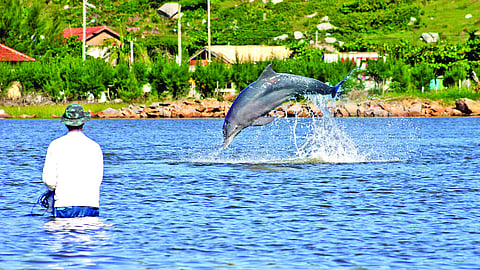

Dolphins, pilot whales and sperm whales use echolocation clicks to hunt and subdue their prey. But the animals, known as toothed whales, also produce other sounds for social communication, like grunts and high-pitched whistles. For decades, scientists speculated that something in the nasal cavity was responsible for this range of sounds, but the mechanics were unclear. Now, researchers have uncovered how structures in the nose, called phonic lips, allow toothed whales to produce sounds at different registers, similar to the way the human voice functions, all while conserving air deep beneath the ocean’s surface. And the animals use the vocal fry register for echolocation. Yes, that vocal fryyyy. The work was published in the journal Science on Thursday.
Studying the structures responsible for whale sound production has been no small task. Over the last few decades, “there was a lot of circumstantial evidence — people filming things with X-rays or triangulating sound with different hydrophones,” said Coen P.H. Elemans, a biologist at the University of Southern Denmark.
Taking a new approach, Dr. Elemans and colleagues inserted endoscopes into the nasal cavities of trained Atlantic bottlenose dolphins and harbor porpoises to get high-speed footage during sound production. They found that sound was indeed being produced in the nose. But to confirm that the phonic lips were involved — and to see if their movement was driven by muscles or by airflow — they created an experimental setup with deceased (beached or bycatch) harbor porpoises, filming the phonic lips as air was pushed through the nasal complex. They saw that the phonic lips would briefly separate and then collide back together, causing a tissue vibration that would release sound into the surrounding water.
But relying on air-driven sound production would not seem to be the best idea if your food is in the murky deep.
“One thousand meters down, you have 1 percent of the air you had at the surface,” said Peter Madsen, a zoophysiologist at Aarhus University in Denmark, who has been tagging toothed whales for decades and is a co-author of the study. “To me, it’s always been super provocative to see a sperm whale or beaked whale or pilot whale dive deep, clicking happily, while having the knowledge in the back of my head that they’re supposed to use air for this.”
Using a combination of sound data from tagged toothed whales diving over 3,000 feet down and the high-speed video they had gathered from living and deceased animals, the researchers stumbled upon a tiny sound that accompanies the loud echolocation click. It turned out to be the milliseconds-brief opening of the phonic lips right before they smack back together, indicating that the whales use air sparingly deep underwater and need very little of it to create a booming echolocation click. “It’s only about 50 microliters of air that are used to generate the next click,” Dr. Madsen said.
That adaptation has major advantages. “You can go deeper and deeper if you need less air,” Dr. Elemans said, and that opens up a whole new world of food — like giant squid. “Sperm whales have access to that because they use this mechanism.”
Visit news.dtnext.in to explore our interactive epaper!
Download the DT Next app for more exciting features!
Click here for iOS
Click here for Android